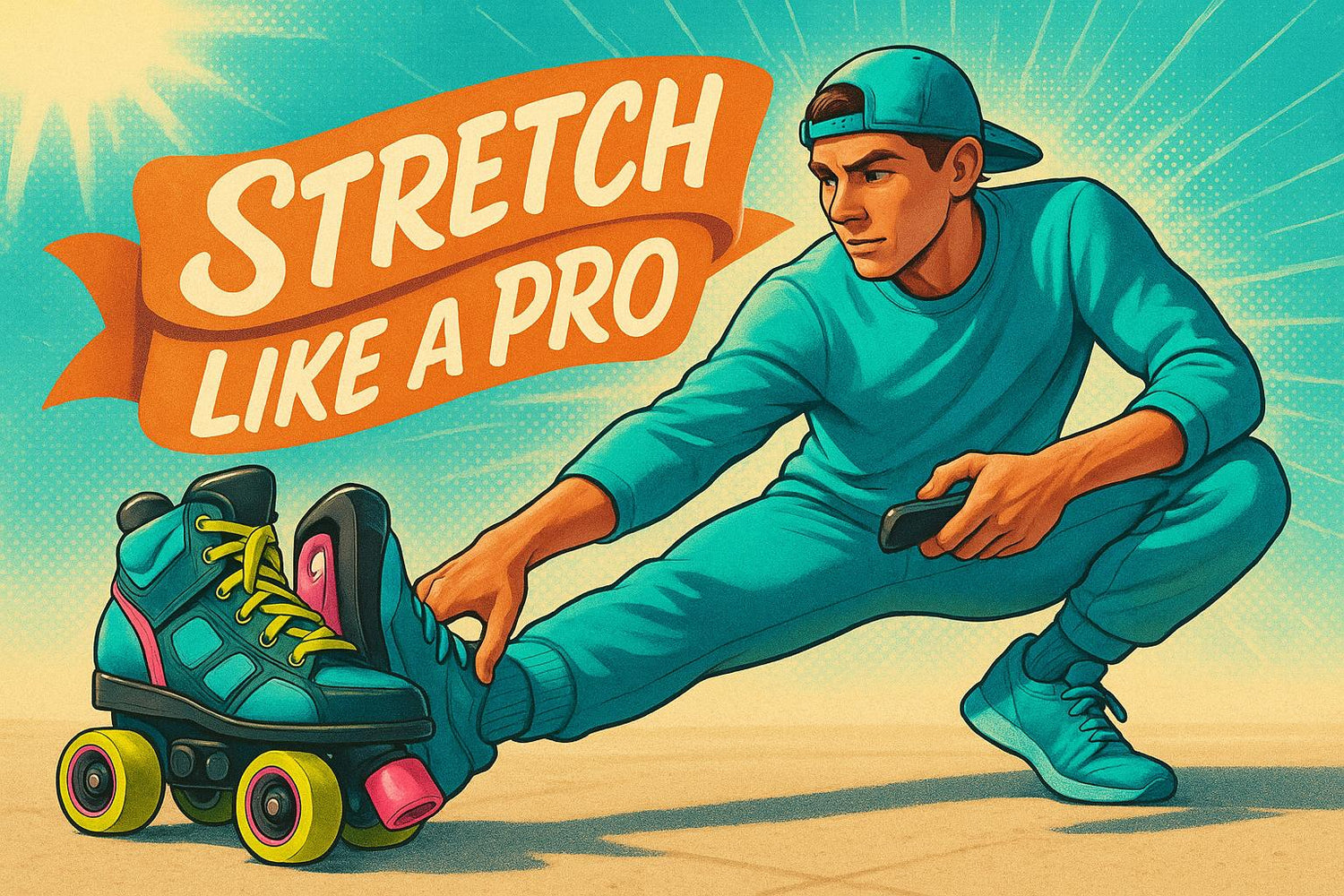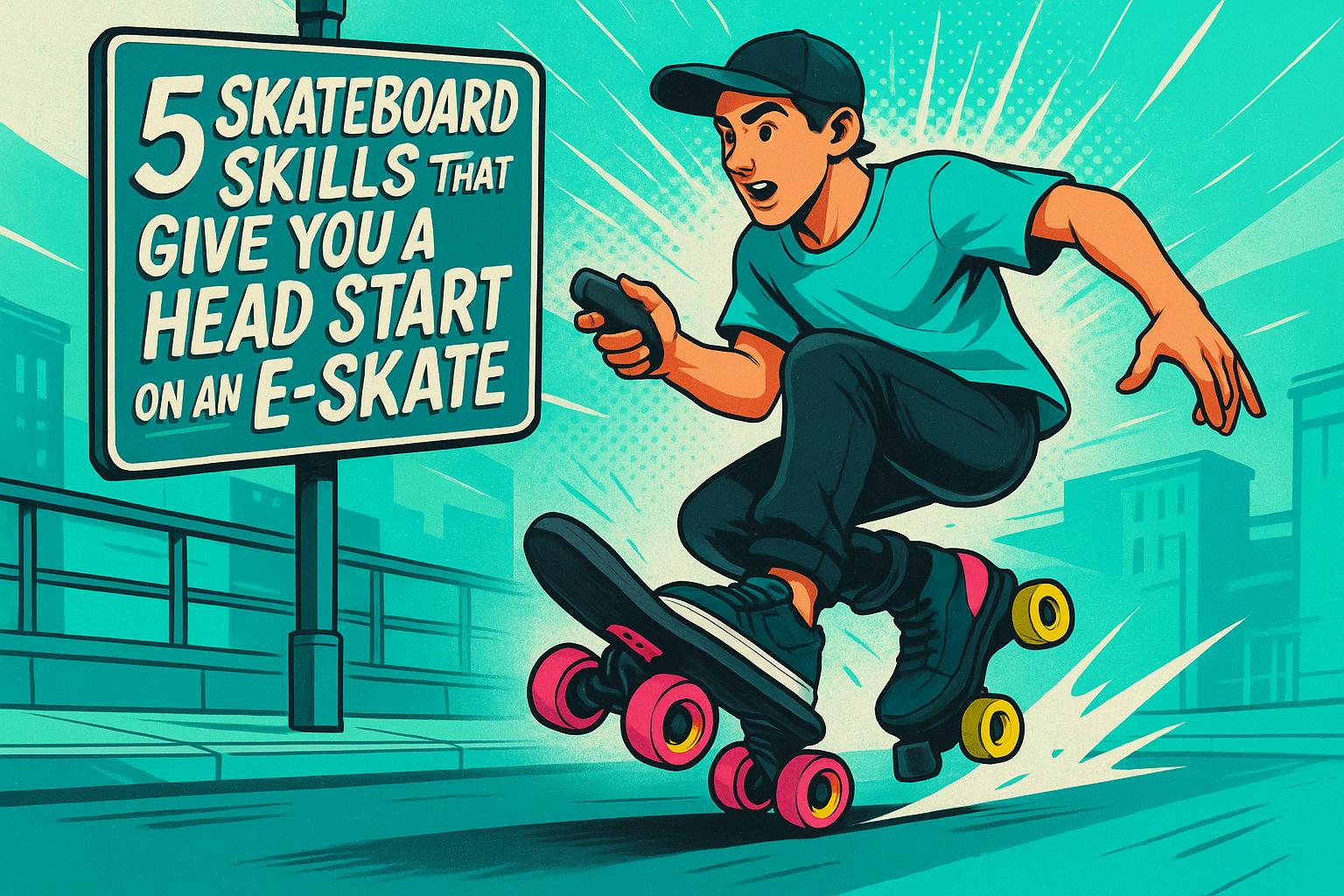Electric roller skating is thrilling, but it can strain your ankles, core, and legs, leading to injuries like sprains, knee strains, and back pain. The solution? Mobility exercises. These moves improve flexibility, balance, and control, helping you skate safely and confidently.
Key Points:
- Why Mobility Matters: Boosts ankle flexibility, hip mobility, and shoulder stability for better skating performance.
- Common Injuries: Ankle sprains, knee strains, back pain, wrist injuries, and hip tightness.
- Prevention Tips: Warm up before stretching, use proper form, and listen to your body.
- Essential Move: Hip Flexor Lunge – reduces tightness, improves posture, and prevents back strain.
- Routine: Dynamic stretches pre-skate, static stretches post-skate, and weekly mobility sessions.
By adding targeted stretches like ankle circles and hip flexor lunges, you can reduce injury risks and feel more in control during every ride.
NO MORE INJURIES Pre-skating/rollerobics routine
Common Skate-Related Injuries
Electric roller skating puts unique demands on your muscles and joints, which can lead to specific injuries if you're not adequately prepared. Recognizing these common injuries emphasizes the need for mobility exercises to keep you safe and steady on your skates. Here's a closer look at some of the most frequent issues skaters face:
Ankle sprains are among the top injuries in skating. Your ankles are constantly working to maintain balance and control as you glide. A sudden bump, sharp turn, or slip can twist the ankle, overstretching or tearing its ligaments. If your ankle joints are stiff, they’re less capable of adjusting to unexpected changes in terrain or direction, increasing your risk of injury.
Knee strains happen when the muscles and tendons around the knee are pushed beyond their limits. Skating requires constant micro-adjustments to stay balanced, which can place significant strain on your knees. Tight hip flexors or hamstrings only add to the problem by restricting your knee’s range of motion, forcing it to work harder than it should.
Lower back pain is another common issue, often caused by the forward-leaning posture many skaters adopt. This position, combined with the impact of skating on hard surfaces, can strain your lower back. Limited spinal mobility can make matters worse, as your core ends up compensating for the lack of movement.
Wrist and forearm injuries frequently occur during falls. When you instinctively reach out to break your fall, the sudden force can lead to sprains or muscle strains. Improving shoulder mobility and core strength can enhance your balance, reducing the likelihood of taking a tumble in the first place.
Hip flexor tightness isn’t an injury on its own but can lead to a chain reaction of problems. Tight hip flexors pull on your lower back and restrict smooth weight shifts, forcing other parts of your body to overcompensate. This imbalance can increase your risk of strains and falls.
These injury risks highlight why mobility exercises are so crucial for skaters. When your joints can move freely through their full range of motion, your muscles don’t have to work as hard, which helps prevent fatigue - a common cause of skating accidents. Better mobility also sharpens your reaction time, making it easier to dodge obstacles or regain balance.
The next section dives into seven essential mobility exercises designed to target these problem areas. These moves will help you improve flexibility, stability, and control, giving you the confidence to skate safely and effectively.
Safety Tips for Stretching
Stretching is a key part of improving mobility, but it’s just as important to do it safely to avoid injuries. By following some basic guidelines, you can make sure your stretching routine helps you progress without setbacks.
Warm Up Before Stretching
Stretching cold muscles can increase your risk of injury because they’re less flexible and more prone to strain. Warming up before stretching not only prepares your muscles but also gets your body ready for physical activity.
Figure skating coach Stephanie Siclari highlighted in November 2022 that spending 5–20 minutes warming up and doing dynamic stretches before hitting the ice can help prevent injuries and mentally gear you up for a skating session. She suggests starting with a 5–10 minute warm-up, followed by 5–10 minutes of dynamic stretching.
"A good warm-up will raise your body temperature, which is particularly helpful to your muscles. As your muscle temperature increases, oxygen becomes more available to your muscles, allowing them to contract and relax more easily - so you'll be able to perform more strenuous tasks with ease. Your heart is also given a chance to prepare, meaning it won't be too strained during your workout."
Start with light activities like jumping jacks, jump rope, or a brisk walk to get your blood flowing and slightly raise your body temperature. Dynamic movements such as leg swings, arm circles, or gentle torso twists are especially helpful for skaters because they activate the muscles you’ll be targeting in your stretches.
Once you’re warmed up, focus on proper form to maximize the benefits of your stretches.
Use Proper Form and Progress Slowly
Good form is more important than the number of stretches you do. Prioritize quality over quantity by performing each stretch with precision. For example, when stretching your hamstrings, keep your back straight and only stretch as far as your hamstrings allow - don’t round your back to go deeper.
Take your time increasing the depth of each stretch. Rushing can trigger your body’s natural reflex to tighten muscles instead of relaxing them.
"Basically cold muscles don't really stretch as much as a warm muscle can. The nervous system is what holds tension in a muscle more often than not, and if not 'warm' it holds more tension."
- Darren Beattie, Owner of Skill Based Fitness.com
Hold each stretch for 20–30 seconds to give your muscles time to adjust. Shorter holds may not be enough to improve flexibility, while holding a stretch for too long can cause unnecessary fatigue without added benefits.
Finally, pay close attention to your body’s signals to avoid overdoing it.
Listen to Your Body
Understanding your body’s feedback is crucial for safe stretching. There’s a difference between the mild tension of a good stretch and the sharp pain that signals potential injury.
You should feel the stretch in the target muscle group - not in your joints or other areas. If you experience sharp pain, burning, numbness, or tingling (especially in your joints), stop immediately. These sensations are warning signs that you’re pushing too far.
Flexibility can vary from day to day, so adjust your intensity based on how your body feels. On stiffer days, ease up on the depth of your stretches.
Avoid bouncing or forcing stretches, as this can lead to muscle tears and reduced flexibility. Instead, ease into each position and use deep, steady breaths to help your muscles relax naturally.
If discomfort persists during or after stretching, it’s a good idea to consult a healthcare professional or certified trainer to ensure your routine is safe and effective for your skating goals.
sbb-itb-bf837b9
Mobility Move to Prevent Skate-Related Injuries
Keeping your hips flexible is a game changer for skaters. It helps maintain proper posture, improves stride, and reduces the risk of lower back strain. One simple yet effective way to achieve this is by adding the Hip Flexor Lunge to your routine.
Hip Flexor Lunge
Spending a lot of time in a forward-leaning skating posture can tighten your hip flexors, limiting your movement and putting extra stress on your lower back. Here’s how to perform the Hip Flexor Lunge:
- Stand upright with your arms relaxed by your sides.
- Place your hands on your hips or rest them on your forward knee for support.
- Step forward with your right foot into a lunge position.
- Bend your right knee at a 90° angle and lower your left knee toward the ground until you feel a stretch in your left hip. Make sure your right foot stays firmly planted.
- Hold the stretch for 20–30 seconds, then switch sides and repeat.
Why it works: This stretch helps loosen up tight hip flexors, which leads to smoother and longer strides. It also supports proper posture and minimizes the chances of lower back strain, especially during long skating sessions.
Adding the Hip Flexor Lunge to your mobility routine is an easy way to boost your hip flexibility and set yourself up for better performance on the rink or the street. Plus, it’s a great foundation for other mobility exercises.
Adding Mobility to Your Skating Routine
Incorporating mobility exercises into your skating routine can make a big difference in performance and recovery. Here's how to structure your mobility work into pre-skate, post-skate, and weekly practices.
Pre-Skate Routine
Kick things off with dynamic movements to improve your range of motion and get your nervous system ready to roll. Split your warm-up into two stages: a general phase at home and a specific phase once you’re at your skating spot.
At Home (General Phase):
Spend 5–10 minutes on dynamic stretches before heading out. Try Ankle Circles to loosen up your joints, the Hip Flexor Lunge to release tightness from sitting or daily activities, and Shoulder Rolls to wake up your upper body.
At Your Skating Spot (Specific Phase):
Once you’re at your spot, focus on movements like ankle rotations, squat holds, and supported calf raises. Add Hip Circles and light pushing drills, gradually building intensity. Skip static stretching here - it can reduce muscle efficiency during your session.
Post-Skate Routine
When your skating session wraps up, it’s time to switch gears to static stretches. Your muscles are warm, making this the perfect moment to work on flexibility and reduce stiffness. Focus on stretches like the Seated Hamstring Stretch and Standing Quad Stretch to help your muscles return to their natural length. The Cat-Cow Stretch is especially great for improving spinal mobility and countering the forward-leaning posture common in skating. Hold each stretch for 30–45 seconds, breathing deeply to promote relaxation. Devoting just 8–10 minutes to a proper cooldown can leave you feeling much better for your next session.
Weekly Stretching Schedule
Aim to practice these movements 3–5 times a week. On skating days, stick to both the pre- and post-skate routines. On rest days, take it further with moves like Side-Lying Leg Lifts and the Cat-Cow Stretch to strengthen your core and improve mobility. Stick with it, and after 3–4 weeks, you’ll notice better range of motion, improved balance, and less stiffness. Consistency really pays off!
Conclusion: Stay Safe and Skate Strong
Taking just a few minutes for mobility exercises can not only help you avoid injuries but also help you perform at your best on your Wheelfeet electric skates. These seven simple stretches target your joints and the muscles around them, improving flexibility and reducing the chances of common skating mishaps.
The best part? It doesn’t require any fancy gear. Devoting 8–10 minutes to focused stretching before and after your rides can make a noticeable difference. Whether you’re zipping along at 15 mph through the city or coasting through a scenic 9-mile route, your body will thank you for the extra care.
Start small by adding moves like ankle circles or hip flexor lunges to your routine. Over time, you can expand your stretch sessions to cover more areas. The consistency you build today will pay off with smoother, injury-free rides in the future.
Prioritize your mobility, and every ride will feel like your best one yet.
FAQs
What are the best ways to include mobility exercises in my skating routine to avoid injuries?
To stay safe and reduce the risk of injuries while skating, it’s important to prepare your body properly. Start with some dynamic stretches like hip circles, ankle rolls, and calf stretches. These movements are great for loosening up your muscles, improving joint mobility, and getting your blood flowing - all of which help your body get ready for the demands of skating.
Adding off-skate exercises to your routine can also make a big difference. Incorporate moves like planks, squats, and lateral lunges during the week. These exercises strengthen the muscles that support your balance and stability, both of which are crucial for skating safely and effectively.
Don’t overlook mobility exercises as part of your warm-up and cool-down. They not only boost your performance but also help prevent injuries, so you can keep skating with confidence.
How can I tell if I’m pushing too hard during my mobility stretches and risking an injury?
When you're stretching, your body has ways of letting you know if you're pushing too hard. Be alert to signs like sharp pain, persistent soreness, or a sense of joint instability. Other warning signals include tingling or numbness, muscle weakness, or difficulty with movement after stretching. In more serious situations, you might notice swelling, bruising, or even muscle spasms.
Pay attention to what your body is telling you - stretching should feel like a gentle, controlled pull, not outright pain. If you notice any of these symptoms, back off and allow yourself time to heal.
Why should you do dynamic stretches before skating and static stretches after?
Dynamic stretches are a must before hitting the skatepark. They get your body warmed up, boost blood flow, and loosen up your joints, prepping the muscles you'll rely on while skating. This not only helps you perform better but also lowers the chance of injuries.
Once you're done skating, static stretches take center stage. These help release tension in tight muscles, improve flexibility, and ward off soreness. They’re essential for recovery and keeping your body in top shape for your next session.




Leave a comment
All comments are moderated before being published.
This site is protected by hCaptcha and the hCaptcha Privacy Policy and Terms of Service apply.